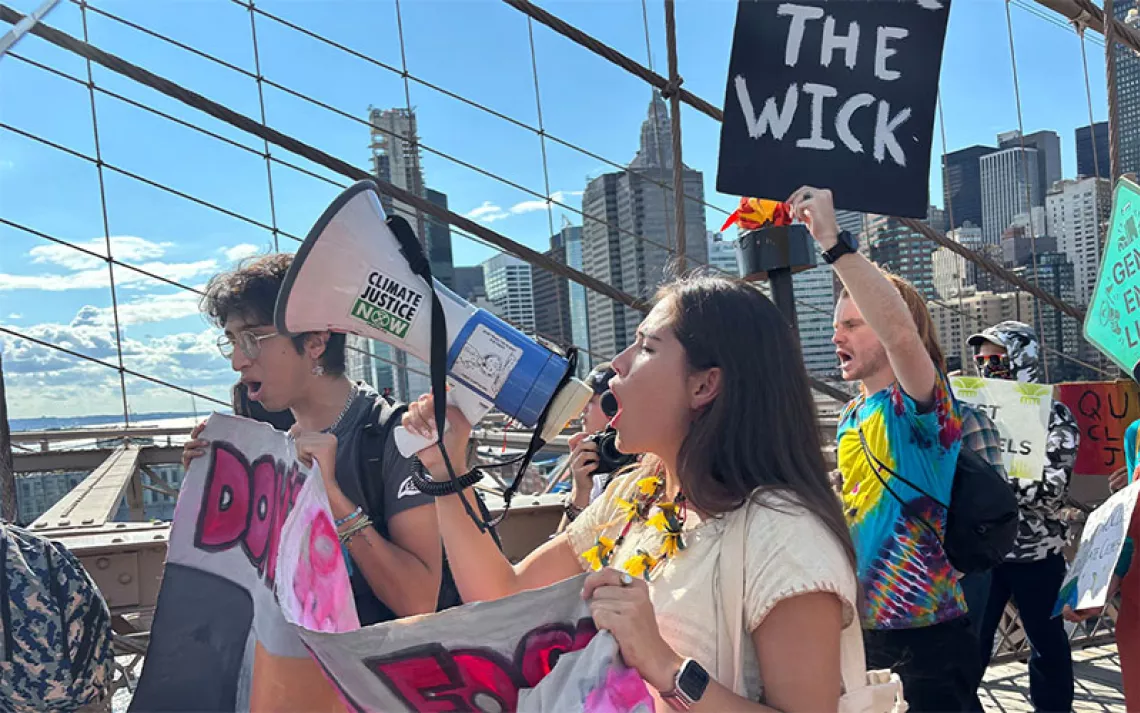Ready to Join the Resistance? Here are 3 Online Tools to Help You Organize
You don’t need to be a professional activist to make a difference

Photo by Hannah Norman
“Not everyone is a full-time activist, but everyone can DO SOMETHING,” wrote Linda Sarsour, co-chair of the Women’s March on Washington and executive director of the Arab American Association of New York, on Facebook a week into Trump’s presidency.
A groundswell of new activists are taking this message to heart, showing up to anti-Trump rallies across the United States. In order to sustain their activism in everyday life, protesters are naturally turning to online resources. Digital organizing is not new, but interest has spiked. The Sierra Club’s digital platform Add Up, which facilitates online petitions and social media campaigns, has seen an unprecedented 330 percent increase in users since Election Day, according to Ryan Dunfee, the site’s community manager. (2,500,000 total actions have been taken on Add Up to date).
Jennifer Earl, a professor of sociology at University of Arizona, points to calls to action on social media as critical in driving political participation. The best predictor for whether somebody will take action is if they’re asked, she explains. Involvement from people new to a cause is also notable. “It’s an important shift in the rise of a movement,” Earl said.
Here are three innovative digital tools, all created by people who are not professional activists, to help you organize more effectively.
The day after President Trump signed the immigration ban into action, Jenn Caballero was fuming. Trained as an attorney, she’d been volunteering at an immigration clinic for the past three years. That week, the mood had sunk. She saw people worried that they would never see their family again or that their legal status could be stripped. “I’ve definitely followed politics, but I haven’t taken action before,” Caballero said. “Ever since the inauguration, it feels like everything is at stake.”
That night, after donating to the ACLU, Caballero furiously typed up a spreadsheet cataloging how U.S. senators responded to the ban, along with their contact information, in hopes of prompting a few friends to make calls. She posted it publicly on Facebook, and when she woke up, the spreadsheet had gone viral. Over 27,000 people have shared her original post to date, and hundreds have commented and emailed, mostly with updates and thank yous, Caballero said. RogueNASA—itself a viral reaction to early Trump administration policies—even tweeted it.
The spreadsheet has now expanded beyond what Caballero ever imagined, thanks to the assistance of friends and strangers from the Internet who volunteered their time. It catalogs statements, stances, and contact information for politicians across House, Senate, and gubernatorial posts. There’s a tab with graphs as well as a template for calling elected officials. But it’s become more than a tool for contacting politicians. Caballero notes that teachers have reached out saying they used it in their lesson plans about immigration policy and executive orders. Another user utilized the spreadsheet for a tough conversation with pro-Trump family members.
“What I like about the spreadsheet is that even though people are using it as a liberal tool to power the resistance, if you look at it, it’s just compiling data,” Caballero said.
Inspired by the #grabyourwallet movement but struggling to keep up? That’s the motivation behind Don’t Pay Trump, a Google Chrome extension that alerts Internet users when they're on a site that sells Trump products or that endorses his presidency. An orange screen covers the browser, prompting viewers to choose an alternative site or tweet at the associated company—including the likes of Amazon, Bloomingdale’s, and Forbes.com.
“We wanted to make something that was simple, that would empower anybody who wants to participate in the boycott,” said Dan Carew, a member of the six-person team. The multiethnic, multigender crew spans the country and is connected through an online chat group. Outraged by just about everything Trump stands for, the DPT team, many of whom work in tech, decided to use their collective entrepreneurial and digital skills for good.
The extension has already been installed over 31,000 times, gaining substantial traction in the past two weeks following inauguration. The reasons why people want to boycott Trump are numerous, noted Carew, from avoiding conflicts of interest to pressuring companies monetarily to hold the president accountable. Already, Nordstrom and Uber, among others, have succumbed to public pressure to cut ties with the Trump family brand and administration. “Trump’s most valuable brand is his ego, and we want to keep pushing that button,” Carew said.
The concept is simple: Input your zip code on the homepage and out pops the closest swing district. For some, that purple area is within driving distance, while for others it’s more of a trek. San Francisco Bay Area users, for example, are directed to California’s 10th District, where Republican Jeff Denham won by only 8,201 votes. Swing Left aims to organize localized teams—well-informed on the community’s key issues and steeped in the representative’s voting record—to continue mobilizing Americans to take action politically. Its goal is to swing the House of Representatives back to Democratic control in 2018, placing an important check on Trump’s aggressive agenda.
Launched the day before inauguration, Swing Left is the result of a collaboration between friends sick of sitting on the sidelines of politics. Ethan Todras-Whitehill, a writer and teacher, Joshua Krafchin, a marketer and entrepreneur, and Miriam Stone, a brand strategist, founded the operation, quickly bringing on additional friends to assist. “We’re citizens who saw something break and rose up to fix it,” Michelle Finocchi, a spokesperson for Swing Left, wrote in an email.
The organization now has nearly 300,000 people signed up, and it’s rapidly growing, Finocchi said. “There’s no question—taking back the House will require a massive effort from progressives all across the country,” she wrote in an email. “But the best way we can do it is by mobilizing countless individuals in all districts who have not seriously participated in the democratic process before.”
 The Magazine of The Sierra Club
The Magazine of The Sierra Club



